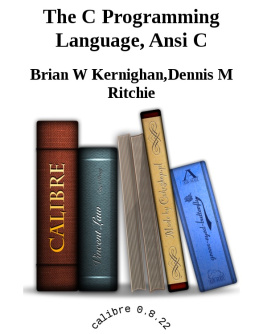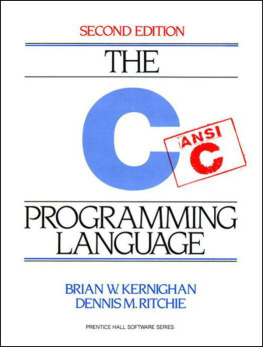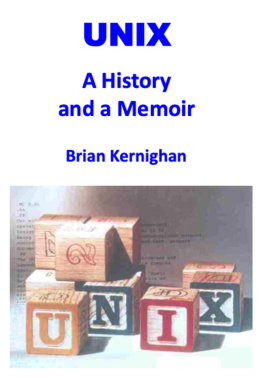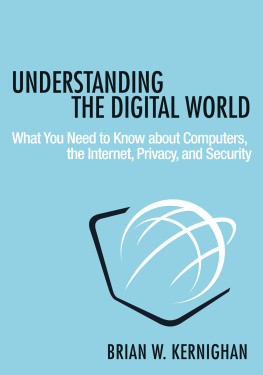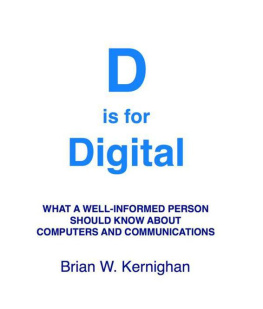Brian W Kernighan - The C Programming Language, Ansi C
Here you can read online Brian W Kernighan - The C Programming Language, Ansi C full text of the book (entire story) in english for free. Download pdf and epub, get meaning, cover and reviews about this ebook. City: Upper Saddle River, NJ, year: 2011, publisher: Prentice-Hall PTR, genre: Computer. Description of the work, (preface) as well as reviews are available. Best literature library LitArk.com created for fans of good reading and offers a wide selection of genres:
Romance novel
Science fiction
Adventure
Detective
Science
History
Home and family
Prose
Art
Politics
Computer
Non-fiction
Religion
Business
Children
Humor
Choose a favorite category and find really read worthwhile books. Enjoy immersion in the world of imagination, feel the emotions of the characters or learn something new for yourself, make an fascinating discovery.
- Book:The C Programming Language, Ansi C
- Author:
- Publisher:Prentice-Hall PTR
- Genre:
- Year:2011
- City:Upper Saddle River, NJ
- Rating:3 / 5
- Favourites:Add to favourites
- Your mark:
- 60
- 1
- 2
- 3
- 4
- 5
The C Programming Language, Ansi C: summary, description and annotation
We offer to read an annotation, description, summary or preface (depends on what the author of the book "The C Programming Language, Ansi C" wrote himself). If you haven't found the necessary information about the book — write in the comments, we will try to find it.
The C Programming Language, Ansi C — read online for free the complete book (whole text) full work
Below is the text of the book, divided by pages. System saving the place of the last page read, allows you to conveniently read the book "The C Programming Language, Ansi C" online for free, without having to search again every time where you left off. Put a bookmark, and you can go to the page where you finished reading at any time.
Font size:
Interval:
Bookmark:
For the most part, this document follows the broad outline of the standard,which in turn follows that of the first edition of this book, although theorganization differs in detail. Except for renaming a few productions, andnot formalizing the definitions of the lexical tokens or the preprocessor,the grammar given here for the language proper is equivalent to that of thestandard.
Throughout this manual, commentary material is indented and written in smallertype, as this is. Most often these comments highlight ways in which ANSIStandard C differs from the language defined by the first edition of thisbook, or from refinements subsequently introduced in various compilers.If the input stream has been separated into tokens up to a given character,the next token is the longest string of characters that could constitute atoken.
constant:
integer-constant
character-constant
floating-constant
enumeration-constant
An integer constant may be suffixed by the letter u or U , tospecify that it is unsigned. It may also be suffixed by the letter l or L to specify that it is long.
The type of an integer constant depends on its form, value and suffix. (See for a discussion of types). If it is unsuffixed anddecimal, it has the first of these types in which its value can berepresented: int , long int , unsigned long int . Ifit is unsuffixed, octal or hexadecimal, it has the first possible of thesetypes: int , unsigned int , long int , unsignedlong int . If it is suffixed by u or U , then unsigned int , unsigned long int . If it is suffixed by l or L , then long int , unsigned long int .If an integer constant is suffixed by UL , it is unsigned long .
The elaboration of the types of integer constants goes considerably beyondthe first edition, which merely caused large integer constants to be long . The U suffixes are new.Character constants do not contain the ' character or newlines; inorder to represent them, and certain other characters, the following escapesequences may be used:
| newline | NL (LF) | \n | backslash | \ | \\ |
| horizontal tab | HT | \t | question mark | ? | \? |
| vertical tab | VT | \v | single quote | ' | \' |
| backspace | BS | \b | double quote | " | \" |
| carriage return | CR | \r | octal number | ooo | \ooo |
| formfeed | FF | \f | hex number | hh | \xhh |
| audible alert | BEL | \a |
The escape \ooo consists of the backslash followed by 1, 2,or 3 octal digits, which are taken to specify the value of the desiredcharacter. A common example of this construction is \0 (not followed by a digit), which specifies the character NUL. The escape \xhh consists of the backslash, followed by x , followedby hexadecimal digits, which are taken to specify the value of the desiredcharacter. There is no limit on the number of digits, but the behavior isundefined if the resulting character value exceeds that of the largestcharacter. For either octal or hexadecimal escape characters, if theimplementation treats the char type as signed, the value issign-extended as if cast to char type. If the character following the\ is not one of those specified, the behavior is undefined.
In some implementations, there is an extended set of characters that cannotbe represented in the char type. A constant in this extended set iswritten with a preceding L , for example L'x' , and is called awide character constant. Such a constant has type wchar_t , an integraltype defined in the standard header . As with ordinarycharacter constants, hexadecimal escapes may be used; the effect is undefinedif the specified value exceeds that representable with wchar_t .
Some of these escape sequences are new, in particular the hexadecimalcharacter representation. Extended characters are also new. The charactersets commonly used in the Americas and western Europe can be encoded to fitin the char type; the main intent in adding wchar_t was toaccommodate Asian languages.Font size:
Interval:
Bookmark:
Similar books «The C Programming Language, Ansi C»
Look at similar books to The C Programming Language, Ansi C. We have selected literature similar in name and meaning in the hope of providing readers with more options to find new, interesting, not yet read works.
Discussion, reviews of the book The C Programming Language, Ansi C and just readers' own opinions. Leave your comments, write what you think about the work, its meaning or the main characters. Specify what exactly you liked and what you didn't like, and why you think so.

